Traditional Freighter
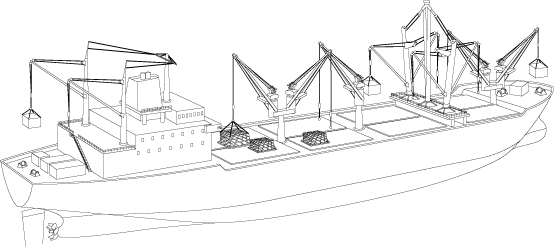
The term freighter is broadly used to describe any vessel that carries freight. However, a traditional freighter carries break bulk cargo as opposed to containerized cargo.
Distinguishing Features: Traditional freighters have many deck-mounted cranes used to transfer cargo from a wharf to the vessel.
Size or Length: Traditional freighters range in length from 250ft (76.2m) to 600ft (182.88m). The "Liberty Ships" of WWII were 441ft (134.4m) in length and 56ft (17m) wide.
Types of Cargo: All types of break bulk (as opposed to wet or dry bulk or containerized) cargo.
How Cargo is Loaded: Freighters utilize numerous deck-mounted cranes to transfer uncontainerized cargo such as cartons, bales, drums, palletized cargo, machinery and vehicles from a wharf or lighter onto the vessel, where longshoremen or stevedores, in a very time-consuming process, stow the cargo into the holds.
Note: Traditional freighters are for the most part obsolete, but are still used in remote parts of the world. Some have been converted to carry containers and dry bulk cargo such as grain, coal, phosphates, fertilizers, and animal feeds. For the most part, they have been sold as scrap metal.
Container Vessel

A Container Vessel is designed to carry uniform-sized ocean freight containers of 20ft (6m) or 40ft (12m) length, 8ft width, and 8.5ft to 9.5ft height.
Distinguishing Features: Containers are loaded into tall slots that extend from three to six containers below deck to three to six containers above deck. The containers are then connected at the corners with locking devices.
Size or Length: Container ships vary dramatically in size and capacity. While most vessel specifications are given in length and width, container vessel specifications are in TEUs or twenty-foot equivalent units (how many standard 20 foot containers the vessel can carry). Very small container vessels might carry as few as 20 TEUs, but modern vessels typically carry 1,000 TEUs or more. Currently, the largest container vessel in the world is 1,060ft (323m) long, 138ft (42m) wide, has a draught of 47.5ft (14.5m) when fully laden and has a capacity of 8,063 TEUs.
Types of Cargo: Container vessels carry any cargo that can be stowed into any of the following container types: general purpose, high cube, hardtop, open top, flat, platform, insulated, ventilated, bulk, refrigerated (reefer) and tank-type containers. Cargo can include merchandise in cartons, bales, drums, cars, furniture, electronics, food, livestock, chemicals and machinery. Oversize cargo such as heavy machinery, trucks, earth moving equipment and pleasure boats can be placed in or on open-top, open-side or flat rack containers or secured to the tops of several containers in a row.
How Cargo is Loaded: Individual containers are loaded by port-based cranes.
Container Vessel with Deck Cranes

A Container Vessel is designed to carry uniform-sized ocean freight containers of 20ft (6m) or 40ft (12m) length, 8ft width, and 8.5ft to 9.5ft height.
Distinguishing Features: Containers are loaded into tall slots that extend from three to five containers below deck to three to five containers above deck. This specific type of vessel also has a number of deck-mounted cranes for on and off loading of containers.
Size or Length: Container ships vary dramatically in size and capacity. While most vessel specifications are given in length and width, container vessel specifications are in TEUs or twenty-foot equivalent units (how many standard 20-foot containers the vessel can carry). Very small container vessels might carry as few as 20 TEUs, but modern vessels typically carry 1,000 TEUs or more. Currently, the largest container vessel in the world has a capacity of 8,063 TEUs, but does not have deck cranes.
Types of Cargo: Container vessels carry any cargo that can be stowed into any of the following container types: general purpose, high cube, hardtop, open top, flat, platform, insulated, ventilated, bulk, refrigerated (reefer) and tank. Cargo can include merchandise of all kinds, cars, furniture, electronics, food, livestock, chemicals, machinery, and products packed in cartons, bales and drums. Oversize cargo such as heavy machinery, trucks, earth moving equipment and pleasure boats can be placed in or on open-top, open-side or flat rack containers or secured above deck on top of other containers.
How Cargo is Loaded: Individual containers are loaded by ship- or port-based cranes.
Ro-Ro (Roll-on Roll-off) Vessel

A Ro-Ro (Roll-on Roll-off) vessel is designed to transport motor vehicles or any other rolling stock
Distinguishing Features: Ro-Ro vessels have a hinged ramp, typically offset at the stern, that allows motor vehicles (automobiles, trucks, trailers, farm tractors, etc.) to drive on and off the vessel.
A Ro-Ro differs from a ferry in that a ferry is designed to carry vehicles and their individual drivers short to medium distances, whereas a Ro-Ro is designed to carry vehicles for wholesale transport without drivers for long distances. For example, a Ro-Ro would be used by an automobile manufacturer such as Honda or Volkswagen to transport hundreds of vehicles at a time across oceans to sell in another country.
Ro-Ro vessels may have as many as eight interior decks, all of which are accessible by interior rampways.
Ro-Ro vessels may also have deck cranes and/or the ability to carry standard ocean containers on deck.
Size or Length: Ro-Ro vessels are typically very large. The largest Ro-Ro vessel is 789.34ft (240.6m) in length, with a tonnage of 67,140 gross tons and 34,376 dwt.
Types of Cargo: Motor vehicles, trucks, buses, tractors, bulldozers, yachts, heavy plant equipment, rail cars, and general cargo. Oversize cargo can be loaded on flatbed or lowboy trailers or placed on deck.
How Cargo is Loaded: Motor vehicles and rolling stock is driven on or rolled onto the vessel via a hinged ramp at the stern.
Heavy Lift Vessel
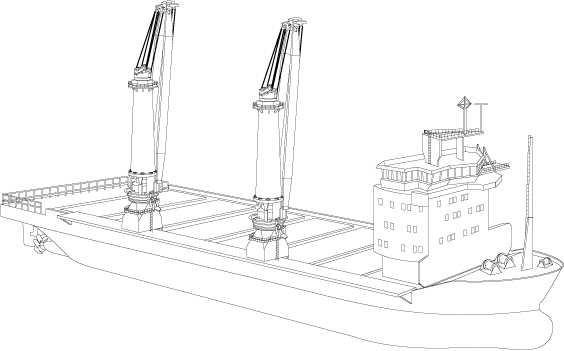
A Heavy Lift Vessel is designed to carry extremely large and/or heavy items that cannot be transported in or on other vessels. Semi-submersible types are designed to transport, lift and unload very large floating objects, including damaged ships. Ro-Ro/heavy lift vessels also exist.
Distinguishing Features: Heavy lift vessels have extremely large cargo decks, unusual deck and pilothouse configurations to accommodate unusual types of cargo and very high-capacity on-deck cranes.
Size or Length: Varies by vessel and type of cargo. A large heavy lift vessel can measure 584.6ft (178.20m) in length and 137.8ft (42m) in width.
Types of Cargo: High-value, complex cargoes such as: transformers, locomotives, rockets, crushers, semi-submersible rigs, jack-ups, oil platforms, bridge spans, TLPs (tension leg platforms) and SPAR buoys, etc.
How Items are Loaded: Cargo is loaded by onboard cranes or shore-based cranes. Conventional loading is the over-the-top Lo-Lo (Load-on/Load-off). Some heavy lift vessels also have Ro-Ro capabilities.
LNG (Liquified Natural Gas) Carrier
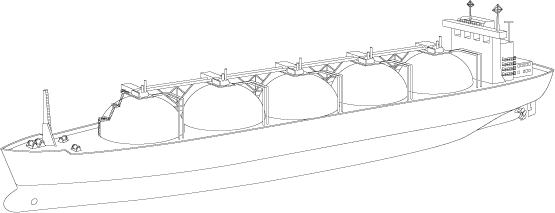
An LNG (Liquified Natural Gas) Carrier is designed to transport natural gas that has been cooled to extremely low temperature (-260ºF/-162ºC) until it contracts into a liquid. LNG compresses to 1/600th of its original volume.
Distinguishing Features: LNG spherical storage tanks are positioned half below and half above the deck.
Size or Length: A conventional LNG carrier has a carrying capacity of 135,000 cubic meters (4,767,480 cuft). The largest LNG tanker has a capacity of 145,000 cubic meters (5,120,627 cuft).
Types of Cargo: Liquified Natural Gas
How LNG is Loaded: The LNG is loaded and unloaded through pumps at specialized terminals. The liquid is then turned back into gas and fed into pipelines for distribution.
Safety Note: Although LNG is a dangerous cargo, LNG tankers have an exceptional safety record, primarily because they are staffed with the best officers and crews available.
U.S. LNG Vessel Note: Due to the dangerous nature of the cargo, U.S. Coast Guard coordinates protection for each trip to a U.S. LNG port, including helicopter patrol, police divers, marine patrol, environmental police, firefighting tugs, city police boats and Coast Guard vessels. Bridges are closed as tankers pass underneath. An established zone of security extends 500 yards on each side, two miles ahead and a mile behind the tanker.
Crude Oil Tanker
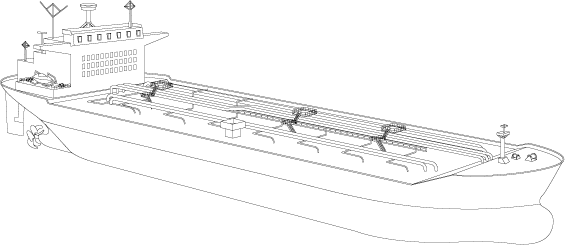
A Crude Oil Tanker is a liquid bulk vessel designed specifically to carry crude oil.
Distinguishing Features: Oil tankers come in all sizes, but the larger "supertankers" are truly giant vessels. The deck of a tanker is covered with pipes and pumps used to transport the crude oil from ship to shore or from hold to hold. All modern oil tankers are double-hulled to protect against oil spills in case of a collision.
Size or Length: Crude oil tankers fall into different categories of size (dwt = deadweight tons):
Handysize Crude Carrier: 10,000-34,999 dwt;
Handymax Crude Carrier: 35,000-49,999 dwt;
Panamax Crude Carrier: 55,000-79,999 dwt;
Aframax Crude Carrier: 80,000-119,000 dwt;
Suezmax Crude Carrier: 120,000-199,999 dwt;
Very Large Crude Carrier (VLCC): 200,000-319,999 dwt;
Ultra Large Crude Carrier (ULCC): 320,000+ dwt.
The largest ULCC is 564,939 dwt.
Types of Cargo: Crude Oil
How Cargo is Loaded: Oil tankers load their cargo by gravity from the shore or by shore pumps, and discharge using onboard pumps.
Dry Bulk Carrier
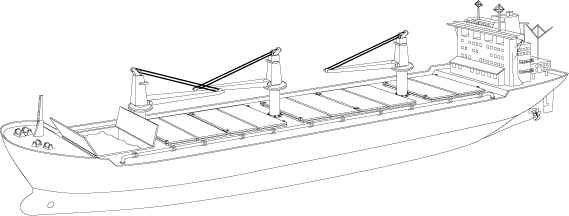
A Bulk Carrier is designed to carry dry bulk cargo.
Distinguishing Features: A bulk carrier typically has a flush deck with numerous waterproof hatches covering holds into which bulk cargo is stored. Some bulk carriers have deck cranes.
Size or Length: Bulk carrier vessels vary greatly in size depending upon the intended cargo and regions served. They range from 10,000 DWT (deadweight tons) to 364,000 dwt in capacity. The longest bulk carrier is 1125ft (343m) in length.
Types of Cargo: Coal, phosphates, iron and other ores, cocoa, grains, fertilizers, animal feeds, scrap metal or other dry, loose cargo.
How Cargo is Loaded: Cargo can be loaded by terminal-based gravity chutes or by shore- or ship-based overhead vacuum pumps, which suck the cargo in and out of the holds of the ship.
Note: Special types of bulk carriers are designed for use on the Great Lakes area of the U.S. and Canada. These vessels transport potash, cement, salt, grain, coal, stone and iron ore.
Canal Barge with Propulsion
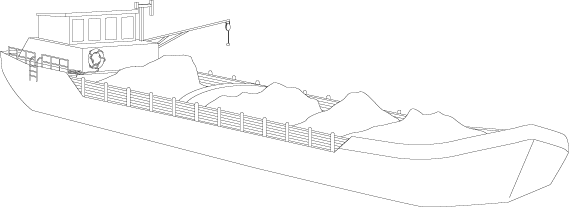
A Canal Barge is designed to carry cargo on the specific canals or waterways it navigates (i.e. Mississippi River, Rhine River, etc.). At issue are the width and length of the waterway's locks (if any) and the depth of the waterway. As a result, barges designed for one waterway may not work on another.
Almost all barges are designed for superior cargo carrying capacity. Freight barges can carry cargo inside the hull or on the deck. Barges are categorized by their physical size, the type of cargo they carry, and the waterways they can travel (i.e., oceans, coast, lakes, bays, sounds, rivers).
Barges are manufactured with propulsion (see illustration above) or without propulsion (see illustration below).
An oil barge is categorized by its barrel or tonnage cargo capacity, its cubic area for cargo, or its deadweight tonnage (DWT)
Distinguishing Features: U.S. river barges are usually flat-bottomed, rectangular in shape, without propulsion and pushed or pulled by powerful tugboat-type vessels.
U.S./Canada Great Lakes barges are often full-sized ships that are long and narrow and have their own propulsion.
European barges are long and narrow to fit through canals and inland waterways. They are also designed to ride low in the water. These barges have special low-draught propulsion systems.
Size or Length: Varies to suit the canal or waterway. Except for the busiest canals, most canals in Europe allow a maximum beam size of about 14ft (4.27m) for barges.
Types of Cargo: Almost anything: crude oil, asphalt, clean oils, gasoline, chemicals, soy bean oil, corn oil, molasses, tallow, dry and dry bulk cargo (containers, lumber, steel, coal, construction equipment, grain, rice, sugar, sand, gravel, railcars, etc.).
How Items are Loaded: Varies by cargo. Typically by a land-based or floating crane for heavy-lift items; by spouting systems fed by conveyors (for grains); by pumps (for liquids); and loading ramps (for vehicles or rolling stock).
Barge without Propulsion
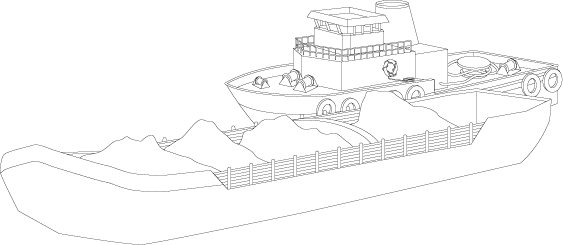
Copyright © 1993-2025 World Trade Press. All rights reserved.

